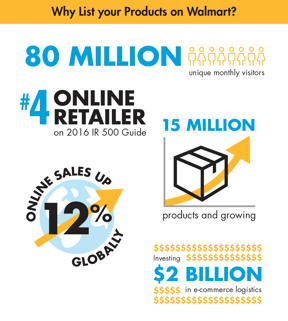How to Reach 80 Million Customers

 When discussing marketplaces where merchants can sell their goods online, Walmart.com isn't the first one that comes to mind. With over 4,600 retail stores in the U.S., however, Walmart is looking to use that as a vantage point over pure ecommerce retailers (Amazon, eBay, Etsy) in order to earn customers' business (and get more eyes on sellers' products in the process). Its Marketplace will become a big part of its success, and while retailers can begin to reach Walmart's more than 80 million unique monthly visitors (see graphic from ChannelAdvisor, click to zoom) by listing there, Marketplace sellers don't have it nearly as good as shoppers of Walmart.com.
When discussing marketplaces where merchants can sell their goods online, Walmart.com isn't the first one that comes to mind. With over 4,600 retail stores in the U.S., however, Walmart is looking to use that as a vantage point over pure ecommerce retailers (Amazon, eBay, Etsy) in order to earn customers' business (and get more eyes on sellers' products in the process). Its Marketplace will become a big part of its success, and while retailers can begin to reach Walmart's more than 80 million unique monthly visitors (see graphic from ChannelAdvisor, click to zoom) by listing there, Marketplace sellers don't have it nearly as good as shoppers of Walmart.com. Like Amazon, there will be pros and cons to listing your products on the Walmart Marketplace, which is currently by invitation only (although the merchant has to express interest by applying to sell there). Before applying, let's look at key ways to prepare to sell on Walmart.com.
1. Study the Demographics
When launching any campaign on a new channel (whether it's an emerging social channel or selling on a new marketplace), it's imperative to understand whether the new channel's audience aligns with a company's target demographic. Not taking into account online versus offline, the average Walmart shopper is a Caucasian, 51-year-old female with an annual household income of $56,482 (source). That said, it's likely that the "younger, richer" demographic that Amazon attracts will be drawn to Walmart.com for the same reasons they shop at Amazon - a wide selection of products that can be delivered quickly and for free.
Retailers shouldn't count out upper-income Americans from ordering on Walmart.com (despite the reasons they may not currently shop in-store), however, if the experience saves them money, is personalized, quick, easy and as expected.
Consider this research: Accenture's 10th Annual Holiday Shopping Survey found that 67 percent of shoppers will purchase items from different stores or websites (than their usual go-to store) to get the lowest price.
2. Recognize Local Limitations
Amazon reports that Walmart stores are located within 10 miles of approximately 90 percent of the U.S. population - this will be an incredible advantage for Walmart but not for Marketplace sellers. Walmart does not currently offer pick-up at store for Walmart Marketplace items.
3. Meet the Partners
From importing orders to managing listings, adding another marketplace to a retailer's list of channels can seem daunting. Thanks to a number of integration partners (Shopify and BigCommerce, for instance), however, the process can be made more efficient. Outside of ecommerce platforms, partners like the previously mentioned ChannelAdvisor can centralize inventory and order management while automating tasks like product categorization and pricing. Retailers will want to check with their ecommerce technology solutions to understand current capabilities and what will be needed to sync inventory, listings and other critical elements.
4. Read the Rules
Nearly 70 percent of online shopping carts are abandoned. Thanks to marketing automation providers, advertising platforms and their own savvy, many retailers have become proficient at deploying marketing campaigns that get those shoppers to return to the site and complete their purchase. With Walmart Marketplace, Walmart owns the buyer and they can not be remarketed to. Other limitations retailers will want to be aware of include:
- Walmart doesn't currently allow customers to exchange items purchased by Marketplace Sellers
- Walmart does not currently offer video support for Marketplace Sellers
- Walmart does not have a feature to send sellers order notifications
- Walmart pays sellers every two weeks (direct deposit into a U.S. bank)
- Walmart.com is currently offering free two-day shipping for orders over $35 on select items, but this program is not applicable to Marketplace Sellers. When a customer places an order that includes items eligible for free two-day shipping and items from Walmart Marketplace, the Marketplace Seller's shipping settings will apply to their part of the order. (For example, if you sell an item and require $3.99 for shipping, a customer receiving free shipping on part of their order will still be charged $3.99 for shipping when they purchase your item.)
5. Know the Advantages
Despite some limitations (like those listed above), there are some real advantages to the Walmart Marketplace for everyday sellers (aside from greater brand reach) including:
- There are no setup, subscription or monthly fees. Walmart deducts a referral fee once a sale occurs on its site
- Credit card fees are already calculated into its referral fees (ranging from 6 percent to 20 percent depending on category)
- Before sellers receive a credit card order, Walmart's security system checks for fraud
- If selected, sellers can request that Walmart collect sales tax on their behalf
6. Check Out the Reporting Abilities
Within the Seller Center, merchants will have access to the following metrics.
7. Apply
Merchants with more questions about selling through the Walmart Marketplace should visit the dedicated website to learn more. Otherwise, the application can be accessed here and takes roughly 10 minutes to complete.








